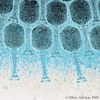Anorexia nervosa is a serious and potentially fatal eating disorder usually characterized by a severely reduced appetite and often a total aversion to food. In the mainstream media, it is most commonly associated with teenage girls and the celebrity quest for a “size zero” figure. However, it is a serious and life-threatening disorder that goes far beyond the realm of body image and extreme dieting. Important clues as to the underlying causes of this disorder may be found in its association with chronic kidney disease.
According to Peter Stenvinkel of the Division of Renal Medicine, Karolinska University Hospital at Huddinge, Sweden, anorexia is observed frequently in kidney dialysis patients. The condition worsens as kidney disease progresses leading to severe muscle wasting and malnutrition, with all its associated health problems. Scientists had suggested a link to defective central nervous system control of appetite, so Stenvinkel and his colleagues have done an analysis of various biomolecules, including natural inflammatory compounds and sex hormones. Their results suggest that inflammation is closely linked to the development of anorexia in kidney patients and is more common in men than women.
Read the full story in today’s SpectroscopyNOW.
 Solid state NMR is unlocking the secrets of compounds found in natural membranes from frogs’ legs to human lungs that could lead to an entirely new class of antibiotic drugs. The compounds in question are antimicrobial peptides (AMPs) and they have been detected in every living creature studied so far. AMPs act as a first line chemical defence system in a huge range of organisms and could provide a novel approach to defeating drugs resistance in bacteria.
Solid state NMR is unlocking the secrets of compounds found in natural membranes from frogs’ legs to human lungs that could lead to an entirely new class of antibiotic drugs. The compounds in question are antimicrobial peptides (AMPs) and they have been detected in every living creature studied so far. AMPs act as a first line chemical defence system in a huge range of organisms and could provide a novel approach to defeating drugs resistance in bacteria. Chemists go veggie
Chemists go veggie The faint glow from a single molecule combined with a stretch from “magnetic tweezers” could help scientists get a grip on how viruses that infect bacteria, so-called bacteriophages pack up their DNA. The research could lead to a resurgence of interest in the West for a potent treatment for infection that uses
The faint glow from a single molecule combined with a stretch from “magnetic tweezers” could help scientists get a grip on how viruses that infect bacteria, so-called bacteriophages pack up their DNA. The research could lead to a resurgence of interest in the West for a potent treatment for infection that uses  No, it’s not some kind of deviant gorillas in the mist story, apparently, millions of years ago our ancestors picked up pubic lice (crabs) either by sleeping in gorilla nests (without the gorilla) or through eating our silver-backed cousins. David Reed and colleagues at the University of Florida publish details of their findings today in BMC Biology journal.
No, it’s not some kind of deviant gorillas in the mist story, apparently, millions of years ago our ancestors picked up pubic lice (crabs) either by sleeping in gorilla nests (without the gorilla) or through eating our silver-backed cousins. David Reed and colleagues at the University of Florida publish details of their findings today in BMC Biology journal. Just £300,000 (about $600k) is being plugged into a national public debate by the UK government on stem cell research. According to Science and Innovation Minister Malcolm Wicks the UK’s two major public funders of stem cell research will use the cash to run a national public discussion about this cutting-edge area of science.
Just £300,000 (about $600k) is being plugged into a national public debate by the UK government on stem cell research. According to Science and Innovation Minister Malcolm Wicks the UK’s two major public funders of stem cell research will use the cash to run a national public discussion about this cutting-edge area of science. Could the contraceptive pill be replaced by a “natural” approach to family planning? It could if a study by Petra Frank-Herrmann of the Department of Gynaecological Endocrinology at the University of Heidelberg, Germany, proves reproducible (pardon the pun).
Could the contraceptive pill be replaced by a “natural” approach to family planning? It could if a study by Petra Frank-Herrmann of the Department of Gynaecological Endocrinology at the University of Heidelberg, Germany, proves reproducible (pardon the pun). Bees making honey from honeydew rather than nectar produce a sweet material that has greater anti oxidant properties than nectar honey, according to a study of 36 honey samples from Spain with different floral origins. The study published this month in the Journal of the Science of Food and Agriculture could point to a way to improve the health benefits of this natural sweetener.
Bees making honey from honeydew rather than nectar produce a sweet material that has greater anti oxidant properties than nectar honey, according to a study of 36 honey samples from Spain with different floral origins. The study published this month in the Journal of the Science of Food and Agriculture could point to a way to improve the health benefits of this natural sweetener. People won’t remember your brand if you advertised during a TV show with a lot of sexual content, according to UK researchers, compared to ads that appear in similar programming with no sex.
People won’t remember your brand if you advertised during a TV show with a lot of sexual content, according to UK researchers, compared to ads that appear in similar programming with no sex.